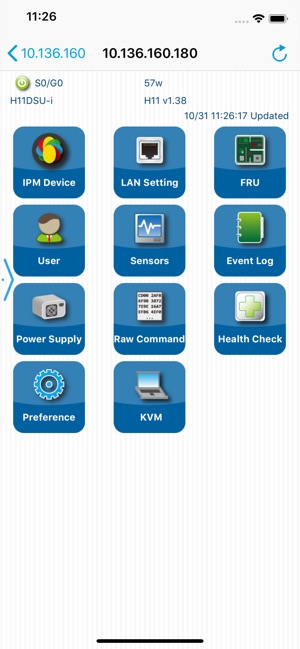There are many utilities for the Integrated Platform Management Interface (IPMI) for various purposes and operating systems. Here, we will provide an overview of valuable IPMI Tools.
- 1Linux
- 2Windows
- 4Manufacturer-specific Utilities
MacOS App wrapper for Supermicro's IPMIView/iKVM java app - TheCase/IPMIView.app.
Linux
IPMItool
IPMItool is already included in numerous Linux distributions.
With IPMItool, you can communicate with IPMI baseboard management controllers (BMCs) in two ways:
- Through the network over a so-called LAN channel. In this case, you only need the IPMItool itself.
- Locally, through a system interface with the BMC for the computer that is currently running IPMItool. In this case, you will need the IMPI device driver from OpenIPMI (see below).
Originally, IPMItool was often packaged together with OpenIPMI by the distribution providers. Since these software utilities are independent of each other, IPMItool is now generally provided as an independent package.[1]
Additional information about IPMItool on the Thomas Krenn Wiki:
OpenIPMI
OpenIPMI consists of two components:
- an IPMI device driver for the Linux kernel
- a user-level library that provides a higher level, abstract interface to IPMI
OpenIPMI updates in RHEL:
Additional information about OpenIPMI on the Thomas Krenn Wiki:
FreeIPMI
Precisely, like IPMItool FreeIPMI makes IPMI queries over the network, as well as locally over a system interface, possible. However, FreeIPMI does not require an IPMI device driver. The code required for access through a system interface has already been integrated into FreeIPMI. Parallel operation of OpenIPMI device drivers and FreeIPMI is not possible.
FreeIPMI has been specially designed for the requirements of High-Performance Computing (HPC) clusters. We at Thomas Krenn use FreeIPMI for the IPMI Sensor Monitoring Plugin (v2 and v3) for Nagios & Icinga.
FreeIPMI in included in RHEL 5 as technology preview.[2]
IPMIutil
IPMIutil is one more utility in the IPMI environment. It is available for Linux as well as Windows, Solaris, BSD and EFI. You will find additional details on the IPMIutil comparison table.
IPMIutil is included with Fedora 14.[3]
Windows
Microsoft IPMI Provider
The Microsoft IPMI Provider is not an independent utility, but rather provides access to IPMI baseboard management controller information utilities as a Windows Management Instrumentation (WMI) provider.
Additional information from Microsoft:
- IPMI Provider (Windows) (http://msdn.microsoft.com)
IPMIutil for Windows
(see #IPMIutil)
iPhone
There are two applications for IPMI on iPhones from www.yellowkompressor.com.
- IPMI touch (kostenpflichtig), IPMI touch from the AppStore
- IPMI light (free), IPMI light from the AppStore
Manufacturer-specific Utilities
Tools from Supermicro
See IPMI Configuration for Supermicro Systems
References
- ↑Bug 466762 - Review Request: ipmitool - Utility for IPMI control (bugzilla.redhat.com)
- ↑http://www.redhat.com/docs/en-US/Red_Hat_Enterprise_Linux/5/html/Release_Notes/sect-Release_Notes-Technology_Previews.html
- ↑http://fedoraproject.org/wiki/Features/ipmiutil
Supermicro provides a set of utilities for configuring IPMI devices on Supermicro servers.
IPMICFG
IPMICFG is an in-band utility for configuring IPMI devices. It is a command line tool providing standard IPMI and Supermicro proprietary OEM commands. This CLI-based utility can be executed on DOS, Windows, and Linux OS and does not require any installation procedures.
We can use IPMICFG (or the standard ipmitool) to mitigate the serious Supermicro IPMI Vulnerability.
- To disable DHCP for the IPMI interface:

- To set the IPMI interface’s IP address to 0.0.0.0:
We can also change the option of the IPMI interface, using raw codes.
- The default is failover:
- Set it to dedicated:
- Verify it:
SMCIPMITool
SMCIPMITool is an out-of-band Supermicro utility that allows a user to interface with SuperBlade systems and IPMI devices via CLI (Command Line Interface). Two kinds of user modes are provided when you start the SMCIMPITool: Command Line Mode and Shell Mode.
SMCIPMITool Key Features:
- Remote IPMI Management
- Remote NM (Node Manager) 2.0 Management
- Remote IPMI Sensor and Event Management
- Remote FRU Management
- Remote IPMI User/Group Management
- Remote Blade System Management
- IPMI Firmware Upgrade
- Virtual Media Management
Tips:
- To set boot device to be PXE in next boot:
- To reset the system and force PXE as the boot device in the next boot only:
IPMIView
IPMIView is a GUI-based software application that allows administrators to manage multiple target systems through BMC. IPMIView monitors and reports on the status of a SuperBlade system, including the blade server, power supply, gigabit switch, InfiniBand and CMM modules. IPMIView also supports remote KVM and Virtual Media.
IPMIView Key Features:
Supermicro Ipmi Download
- IPMI System Management
- KVM Console Redirection
- Text Console Redirection
- Virtual Media Management
- IPMI User/Group Management
- Trap Receiver
- Mobile App (Android, iOS)
Supermicro Ipmiviewer For Macos Download
Tips:
Supermicro Ipmi Viewer For Mac Os Update
- On Windows, run IPMIView as administrator;
- To have a better experience running IPMIView on a Windows 10 system with a High DPI display, right click IPMIView20 icon, choose Properties from the menu, go to the Compatibility tab, check “Override high DPI scaling behavior. Scaling performed by:”, and select System.



